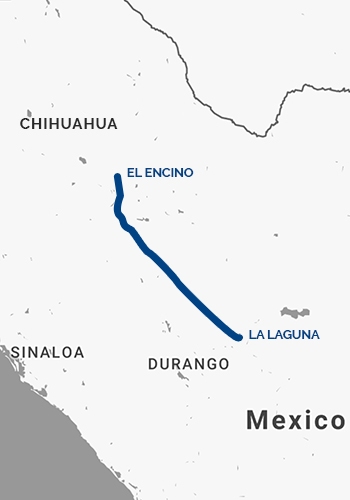Mexico Shows Elevated Methane Emissions from Gas Pipeline, Scientists Report
(Reuters) — Mexico emitted "extreme" amounts of methane from a natural gas pipeline running through its northern border state, Durango, in 2019, a research paper published on Tuesday showed, citing data collected from satellites.
Methane, a potent greenhouse gas that traps heat in the atmosphere and warms the planet much faster than carbon dioxide in the short term, is considered a top threat to the climate.
Scientists from Harvard University, led by Marc Watine and Daniel Varon, identified a hot spot in Durango that released thousands of metric tons of methane over two months.
Watine said the team was able to trace the methane leaks to the El Encino-La Laguna pipeline that passes through the states of Chihuahua and Durango, transporting natural gas from the United States to Mexico.
"Our analysis shows that there were emissions from several different parts of the pipeline between April and May that year," Watine said in an interview. "Not all of it came from one location."
On May 12, 2019, between 260 and 550 tons of methane were released per hour from one location, totaling 1,130 to 1,380 tons over three hours, the scientists found.
It was not clear what caused the emissions or which company was responsible for them.
Government documents showed the pipeline, owned by state-owned power utility CFE, is operated by Fermaca Pipeline El Encino.
CFE did not immediately respond to a request for comment and no contact details are listed in public documents for Fermaca Pipeline El Encino.
Scientists have said Mexican companies, including state energy company Pemex, lag behind their obligations to identify, report and mitigate emissions from their infrastructure.
In September 2022, another group detected two methane leaks from Pemex infrastructure in the Ku-Maloob-Zaap oil field cluster in the Gulf of Mexico.
Methane, the main component of natural gas, is invisible and odorless. However, in recent years satellite technology has evolved to make detection possible and more accurate.
The latest research was published in the Proceedings of the National Academy of Sciences, a peer reviewed journal.
Related News
Related News

- Kinder Morgan Proposes 290-Mile Gas Pipeline Expansion Spanning Three States
- Three Killed, Two Injured in Accident at LNG Construction Site in Texas
- Tallgrass to Build New Permian-to-Rockies Pipeline, Targets 2028 Startup with 2.4 Bcf Capacity
- TC Energy Approves $900 Million Northwoods Pipeline Expansion for U.S. Midwest
- U.S. Moves to Block Enterprise Products’ Exports to China Over Security Risk
- U.S. Pipeline Expansion to Add 99 Bcf/d, Mostly for LNG Export, Report Finds
- Enbridge Adds Turboexpanders at Pipeline Sites to Power Data Centers in Canada, Pennsylvania
- Great Basin Gas Expansion Draws Strong Shipper Demand in Northern Nevada
- Cheniere Seeks FERC Approval to Expand Sabine Pass LNG Facility
- Heath Consultants Exits Locate Business to Expand Methane Leak Detection Portfolio





Comments